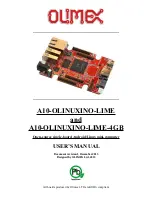
COMe-mEL10 - User Guide Rev. 1.1
// 38
3.4.
Fast I2C
The fast I2C bus transfer data between components on the same module with transfers at up to 400 kHz clock speeds.
The I2C controller supports:
Multi-master transfers
Clock stretching
Collision detection
Interruption on completion of an operation
To change the I2C bus speed, in the BIOS setup menu select:
Advanced>Miscellaneous>I2C Speed> 400 kHz to 1 kHz
The default speed is 200 kHz.
3.5.
GPIO
Eight GPIO pins are available, with four pins for the in-direction (pin A54 for GPI0, pin A63 for GPI1, pin A67 for GPI2 and
pin A85 for GPI3) and four pins for the out-direction (pin A93 for GPO0, pin B54 for GPO1, pin B57 for GPO2 and pin B63
for GPO3). The type of termination resistor used sets the direction of the GPIO, where GPIs are terminated with pull-up
resistors and GPOs are terminated with pull-down resistors.
Due to, the fact that both the pull-up and pull-down termination resistors are weak, it is possible to override the
termination resistors using external pull-ups, pull-downs or IOs. Overriding the termination resistors means that the
eight GPIO pins can be considered as bi-directional since there are no restrictions whether you use the available GPIO
pins in the in-direction or out-direction.
The COMe-mEL10’s GPIO pins are pin shared with SDIO pins. GPIO is the default and SDIO an option supported using the
processor. Hardware assembly defines whether the shared pins are GPIO or SDIO. There is no BIOS or software option to
change the shared pins.
Configuration must be performed using the OS driver.
3.6.
Hardware Monitor (HWM)
The Hardware Monitor (HWM) Nuvoton NCT7802Y controls the health of the module by monitoring critical aspects such
as the module’s processor temperature using thermal resistors, power supply voltages and fan speed for cooling.
The SMART FAN ™ technology controls the duty cycle of the fan output (FAN_PWMOUT) with temperature setting
points. This enables flexible fan control for cooling solutions and noise sensitive solutions. For system protection, users
can set threshold values for alarm signals.
The HWM is accessible via the System Management (SM) Bus address 5Ch, see Chapter 4.2: System Management (SM)
Bus.
The HMW bus address is 5Ch.







































